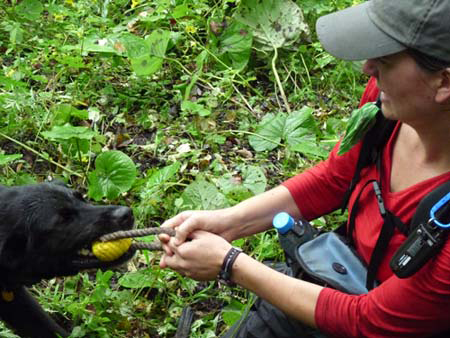Conservation biology: Going to the dogs
(This article originally appeared in SCBI News, the newsletter of the Smithsonian Conservation Biology Institute)
Scientists are known for being ingenious at taking advantage of every possible tool to make their research projects yield the best data possible.
On several SCBI projects, scientists have turned to a unique detection tool: dogs.
Dogs’ noses are famously and fantastically sensitive. They have 40 times more scent-sensitive cells in their nose than humans do. And unlike cumbersome, heavy and very finicky equipment, dogs can go everywhere human scientists can go, and even some places they can’t.
The scientists use their canine collaborators to sniff out the bits of themselves animals often leave strewn about their environment—hair, feces, urine, feathers, shed skin, even saliva. Using these samples, scientists can study the DNA of the animal and discover its sex, hormone levels, range, movement, mating patterns and how related it is to other animals in the area.
SCBI ecologist Bill McShea and his team are studying Asiatic black bears in China. They’re comparing stress hormones from bears inside eight nature reserves to bears outside the reserves. They hope to use these findings to quantify how effective the reserves are at protecting the bears.
Biologists, like SCBI’s Janine Brown, can extract stress hormones from the bears’ feces. McShea’s team has been conducting research in this area for three years. Mainly, they find scat because they know to look under trees that have limbs broken at the top. Bears like to climb trees as high as they can, and break the higher branches to get access to fruits and seeds, so under those trees you can be sure to find scat.
In that time, they’ve found about 600 fecal samples, most of them from inside the reserves. However, for the study to be statistically rigorous, they need ample samples from outside the reserves as well, to make sure they’re making fair comparisons and drawing reliable conclusions.
To help them find those elusive feces outside the reserve, the team enlisted the help of Aimee Hurt and Working Dogs for Conservation, a group that trains dogs to smell out scat, or whatever else the scientists are looking for. SCBI scientists Jesus Maldonado and Kathy Ralls have had great success with Working Dogs for Conservation.
Besides being better equipped to detect scat in the first place, dogs also are free from the prejudices and preconceived notions the scientists had. McShea explains, “This dog knew nothing about those broken trees [we usually bias our search toward]. It went up there and searched everywhere. It found scats in places we never look.” Graduate student Karl Malcolm led the team to locations that were known to have bears but the human searchers had not been highly successful finding feces.
McShea said that the dog, a black lab named Wicket works the same way a hunting bird dog works: “Aimee, the trainer, walks up and down the hillside, and the dog loops up and back to the trainer the whole time. Wicket is working for a reward, which is a certain toy. The dog lives to play with this toy, which is basically a ball on a string. The toy stays in a fanny pack on the trainer. It only comes out when the dogs finds a scat. No scat, no toy.”
Posted: 4 February 2011
-
Categories:
Feature Stories , Science and Nature , Zoo & Conservation Biology Institute





